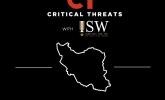Iran Crisis Update, November 28
November 28, 2022 - ISW Press
Social media users circulated calls for protests following the US-Iran world cup match on November 29 although it is unclear to what extent these demonstrations will materialize. Some protest organization groups and other prominent social media users circulated calls for protests on November 29, possibly in an attempt to coopt or challenge pro-regime celebrations on city streets. Some social media users disagreed with the November 29 call to protests and highlighted pre-organized protests scheduled for December 5-7. Another anti-regime social media user circulated ways to support the protest movement until demonstrations resume on December 5, further suggesting that protesters remain focused on unrest planned for December 5-7. The Neighborhood Youth of Karaj protest organization similarly alluded to requiring more time to reinforce its organizational capabilities and supplies before protests resume on December 5, as CTP previously reported. Recent social media activity from groups purporting to be protest organizations suggest diverging approaches to coordinating unrest, one of which calls for large crowds and emphasizes continuous protest activity, the other of which seemingly requires more time and preparation. This rhetorical schism could indicate that protest organization groups remain primarily local and lack a coherent, nation-wide structure.






